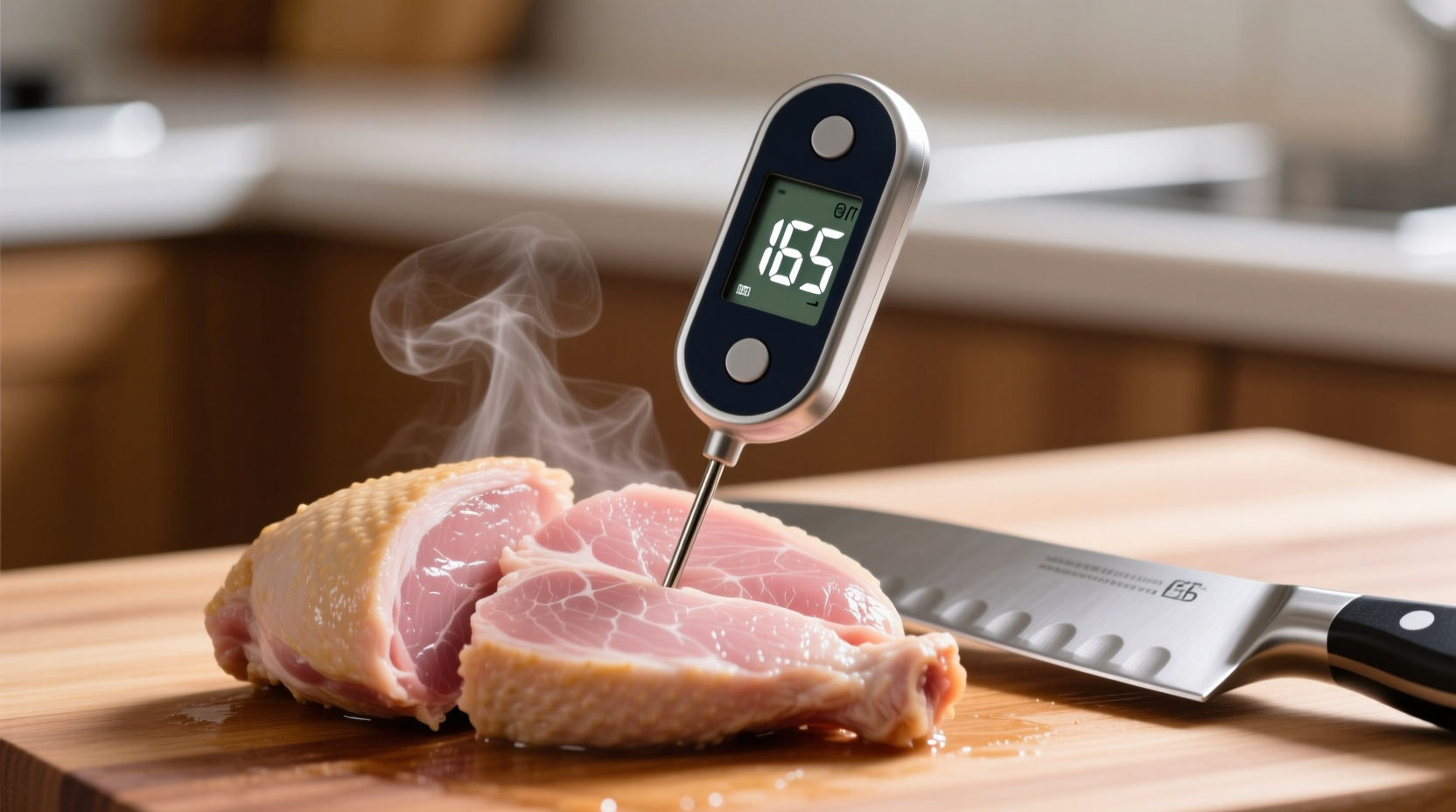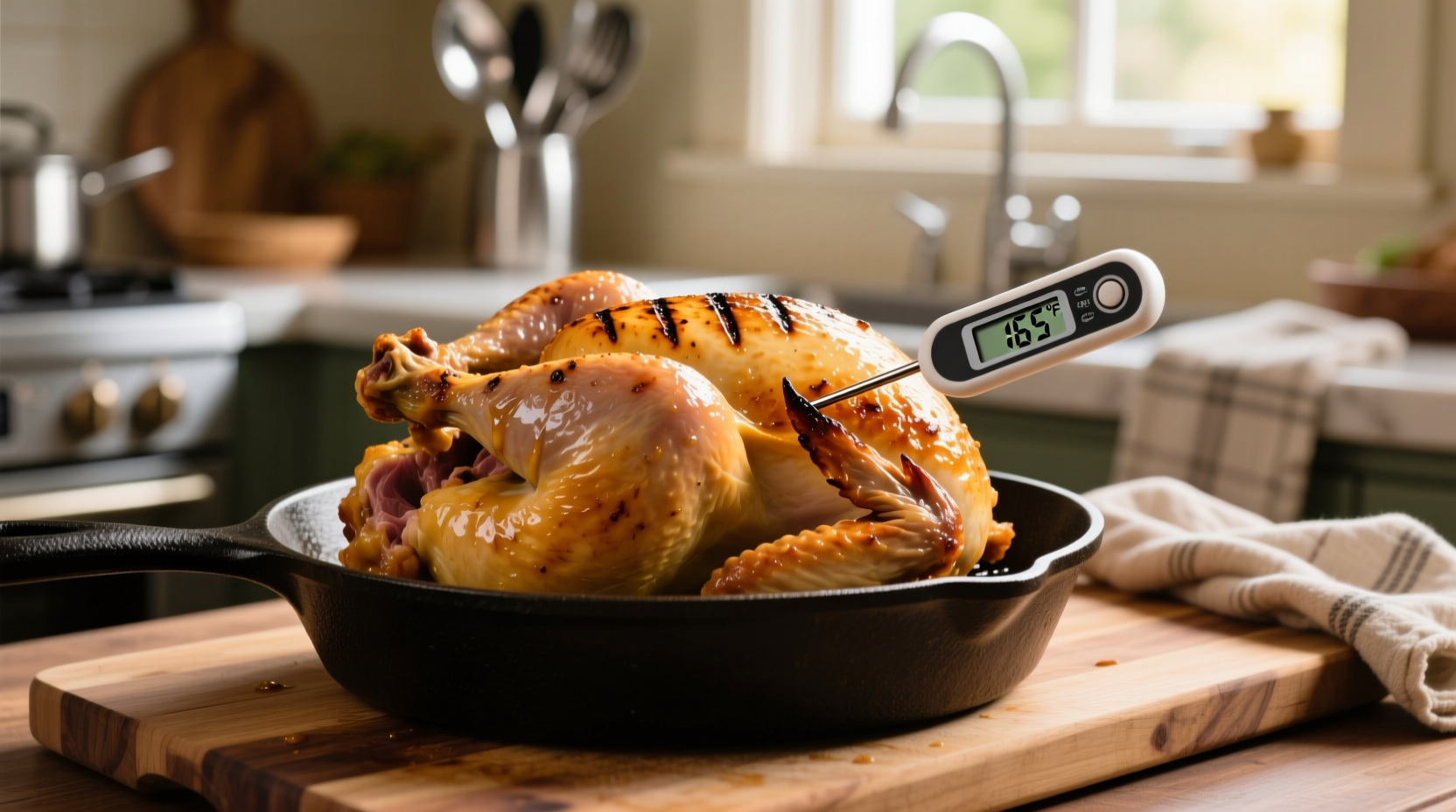Chicken must reach 165°F (74°C) internally to be safe to eat. This temperature instantly destroys harmful bacteria like Salmonella and Campylobacter. Use an instant-read thermometer in the thickest part of the meat, avoiding bone, for accurate results.
Nothing ruins a perfectly grilled chicken dinner faster than foodborne illness. Understanding the precise temperature required to safely cook chicken isn't just culinary advice—it's a critical food safety measure that protects you and your family. While many home cooks rely on visual cues like color or juice clarity, these methods are dangerously unreliable. The only guaranteed way to ensure chicken is safe is by verifying its internal temperature with a reliable thermometer.
Why 165°F Is Non-Negotiable for Chicken Safety
Chicken naturally contains harmful bacteria including Salmonella and Campylobacter that can cause serious food poisoning. The USDA's Food Safety and Inspection Service (FSIS) established 165°F as the minimum safe temperature because at this point, pathogens are instantly destroyed. This isn't arbitrary—it's based on extensive microbiological research documented in the USDA's Chicken and Food Safety guidelines.
| Temperature | Time Required to Destroy Salmonella | Practical Implication |
|---|---|---|
| 130°F (54°C) | Over 1 hour | Impractical for cooking; chicken would be raw |
| 140°F (60°C) | Over 30 minutes | Texture would be unacceptable |
| 150°F (66°C) | Approximately 3 minutes | Still risky without precise timing |
| 165°F (74°C) | Instant | Guaranteed safety with no timing concerns |
This temperature timeline explains why the USDA settled on 165°F as the standard—it eliminates the guesswork and timing precision required at lower temperatures. Attempting to cook chicken to lower temperatures (like 150°F) requires maintaining that exact temperature for specific durations, which is extremely difficult to manage consistently in home cooking environments.
Choosing and Using the Right Thermometer
Not all thermometers deliver the accuracy needed for proper chicken safety. Here's what matters:
- Instant-read digital thermometers provide readings in 2-5 seconds with ±0.5°F accuracy—ideal for checking multiple spots
- Leave-in probe thermometers work well for roasting or grilling, alerting you when target temperature is reached
- Avoid dial thermometers that require 1-2 inches of stem insertion—they're less accurate and slower
Proper technique matters as much as the tool. Insert the thermometer into the thickest part of the chicken, avoiding bone, fat, or gristle. For bone-in pieces, insert from the side to reach the center of the meat near the bone. Check multiple spots in larger pieces like whole chickens or turkey breasts.

Temperature Consistency Across Chicken Cuts
Whether you're cooking a chicken breast, thigh, wing, or whole bird, the safe temperature standard remains the same: 165°F throughout. Many home cooks mistakenly believe dark meat requires different temperatures than white meat, but food safety standards don't vary by cut.
The difference lies in texture and moisture retention. Dark meat contains more fat and connective tissue, so it can tolerate higher temperatures without drying out, but it still must reach 165°F for safety. White meat has less fat, so it dries out more quickly once it passes 165°F, making precise temperature monitoring even more critical.
Debunking Common Chicken Cooking Myths
Despite what many believe, visual indicators alone cannot confirm chicken safety:
- "Juices running clear" myth: Chicken can appear to have clear juices while still harboring dangerous bacteria
- Color change myth: Chicken can appear white and cooked at temperatures as low as 140°F—well below the safety threshold
- "Touch test" myth: Firmness varies based on cut and cooking method, not safety
The FDA Food Code explicitly states that visual indicators should never replace thermometer use for poultry. A study published in the Journal of Food Protection found that 30% of chicken deemed "done" by visual cues alone was still below 160°F.
Troubleshooting Temperature Issues
If your chicken is under 165°F: Return it to heat immediately. For grilled or pan-seared chicken, tent with foil and finish in a 350°F oven to prevent over-browning. For roasted chicken, continue roasting and check temperature every 3-5 minutes.
If your chicken exceeds 170°F: While still safe, it will likely be dry. Counteract this by slicing against the grain, serving with sauce or gravy, and ensuring proper resting time (5-10 minutes) to redistribute juices.
Temperature variations during cooking: Chicken continues to cook during resting (carryover cooking). Remove chicken from heat at 160-162°F to reach 165°F during the 5-minute rest period. This prevents overcooking while ensuring safety.
Special Consideration: Sous Vide Cooking
For sous vide enthusiasts, lower temperatures are possible with precise time controls. At 145°F, chicken must maintain this temperature for 9½ minutes to achieve the same pathogen reduction as 165°F instantly. However, this requires specialized equipment and strict timing that most home kitchens cannot reliably maintain. For conventional cooking methods, 165°F remains the only recommended standard.
Practical Temperature Checklist for Home Cooks
- Calibrate your thermometer before each use (ice water test)
- Insert into thickest part, avoiding bone
- Check multiple spots in larger pieces
- Verify 165°F in all areas
- Allow 5 minutes rest time before serving
- Clean thermometer with hot, soapy water after each use











 浙公网安备
33010002000092号
浙公网安备
33010002000092号 浙B2-20120091-4
浙B2-20120091-4